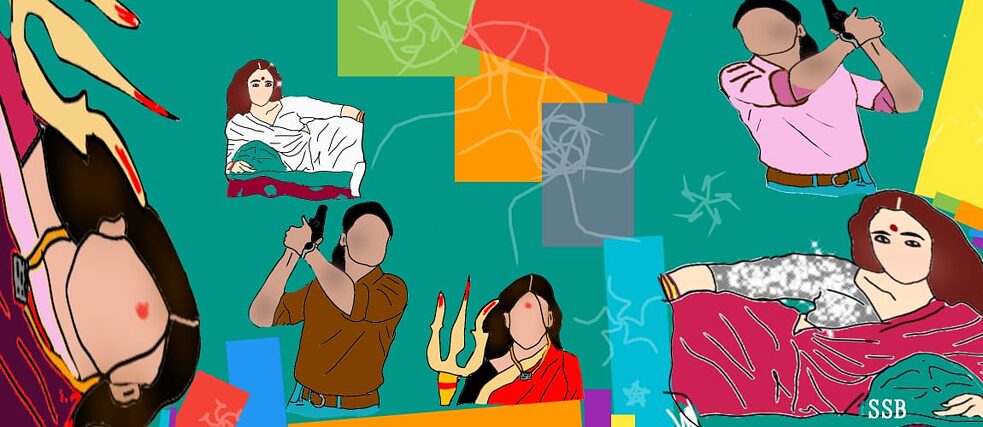By Mashaekh Hassan
Gold-Washing the Bollywood Heroine

A woman can only be considered a hero when she has walked many miles to ensure justice. The problematic aspect here is that - the constant portrayal of a savior as hero/heroine invalidates the struggles of a victim. A rape victim’s will to live with the trauma and a prostitute's way of negotiating her place within the society as a part of reality is never shown as heroic, despite the struggles the choices come with.
Dominated mainly by cis-normative and heteronormative narratives, Bollywood, the blockbusting machine among the manifold Indian film industries, has produced different kinds of female characters.
Unconventionally strong physical capabilities
Outstanding physical strength is not considered a feminine trait in many societies, if we are to look at essentialist sexist constructs; yet, the overwhelming power of a ‘goddess’ is naturalized myth in India; bringing the mythical to the mundane, Bollywood creates mythic conventions that appear to be ‘unconventional.’ Blessed with supernatural powers, Bulbbul from the movie Bulbbul (2020) is shown as a goddess. So, automatically she’s more than a normal woman. Shown as an officer with a mission to save some girls from forced prostitution, the lady officer from Mardani (2014) and Mardani 2 (2019) being a police officer is, obviously, equipped with rigorous physical training that posits her in somewhat a superior position to the women in need of help. The title Mardani, in fact, directly translates to “masculinity”. In Manikarnika: The Queen of Jhansi (2019), the queen is shown fighting on the battlefield, carrying her child on her back. The archetypical ‘feminine strength’, re-normalized into state machinery (in the case of Bulbul), or re-valorized in the case of the mother-queen, automatically made them heroes, for they are using it to actualize what’s expected. The child is clearly an added burden, used to show how the physically strong woman is still a mother, fulfilling her duties. In the case of male heroes, I believe, a temporary leave from fatherhood is justified because, unlike women, they are busy saving their lives.
Is then the switch from ultra-feminine heroine in conventional roles supporting the male lead to super-feminine ‘hero’ some kind of gold-washing?
The urge to ensure a specific kind of justice that’s legitimized by the state
This is especially applicable to the portrayals of forced prostitution and rape considering these are mostly counted as women's issues. A woman can only be considered a hero when she has walked many miles to ensure justice. The problematic aspect here is that - the constant portrayal of a savior as hero/heroine invalidates the struggles of a victim. A rape victim’s will to live with the trauma and a prostitute's way of negotiating her place within the society as a part of reality is never shown as heroic, despite the struggles the choices come with. In movies like Lakshmi (2014), the girl who “ensured justice” by imprisoning the criminals (the dealers, owner of the brothel, political figures) is shown as the hero. In Pink (2016), the mother is shown as the hero because she killed the rapist of her daughter, ensuring another kind of “justice” from a de-legalized standpoint. While this does de-legitimize male violence, one of the biggest issues which gets lost in the portrayals is how difficult the reintegration of the victims is within the given context. Imprisoning the rapist or the local dealers does not automatically translate to the victims’ and prostitutes’ reintegration into society; or their survival at its margins.
The afterlife of the victim, which in fact could be construed as heroic in the Gogolian sense of little people’s afterlives as their struggles appear neverending, in spite of the movie hero’s heroic moves, is never portrayed. Thus, mundane heroism, brown to the bone and red as blood, is not foregrounded.
Positioning sex positivity and monogamous feelings at different ends of a spectrum
Portrayals of prostitutes, hero or not, are both sexualized and heavily desexualized at the same time. To be precise, not against sex, given that it’s a profession, which should not be compared to having a personal preference to explore sexuality and/or be as sexual as they wish. However, whenever there’s a moment where the hero-lady is shown in a non-transactional sexual context, the traditional idea of femininity appears out of the blue. She is sex-positive, but she is not sexual anymore when she’s falling for someone. She is sexual but wants to take time before entering into sexual dynamics with the person they see a potential future with.
The soft corner reserved for a partner is one of the traits they possess, and in most cases, it is cis-normative, hetero-normative, and against the notion of pre-marital sex.
Nowhere in portrayals of male heroes have I ever seen sex-positivity. Hypersexuality, however, can be one of the traits of the portrayed hero but never a criterion of being considered a hero.
Injecting a hybrid of struggling class vocabulary and middle-class syntax (applicable for both male and female heroes)
For some reason, regardless of their class backgrounds, all the women heroes are eloquent. Probably for the dramatization of certain scenes, there are some goosebump-inducing moments wherein the hero managed to speak a long monologue. Although the pronunciation indicates an influence of an unstandardized regional dialect (reference: the Madames of brothels, or a prostitute), the constructed sentences, somehow, follow the standardized rules: "Inko sirf humare dukan pe etraj kyun? Sirf hamara hi dhandha beijjat kyun? Admi log aate hain, apki hi mahalle se hamari mahalle mein, fir bhi hamari hi mahalla badnam kyun? Aap log jante ho, duniya ki sabse purana pesa kaun sa hai? Besyaon ka. Humare bina to swarg bhi adhura hai bhai. Thodi to ijjat deni paregi..." (Translation: "Why do they object only to our establishments? Why is only our profession viewed as immoral? Men from your neighbourhood come to us and yet our neighbourhood is infamous. Why? Do you know what is the oldest profession in the world? Prostitution. Without us, even the heaven is incomplete. You must give us some respect...")
In the case of Mardani and Kahani, both the portrayed women heroes belong to an affluent class; Rani, the protagonist of Mardani, is a first class police officer and Vidya, protagonist of Kahani, is a software engineer and a resident of the USA. Predictably, both of them had the privilege of growing up listening to the standardized version. Needless to mention how even the eloquence is also directly connected to affluent classes’ privilege which women from lower socioeconomic backgrounds cannot easily attain.
A portrayal of a hero like this invalidates the struggles of women who are fighting for their existence without the particular ‘social capital’ of enchanting people with their words. This is especially problematic for the movies that claim to be based on real-life incidents.
Gangubai Kathiawadi (2022), for instance, is one such movie that was “inspired” by a chapter of the book “Mafia Queens of Mumbai” published by Hussain Zaidi in 2011. The movie heavily differed from how it was mentioned in the said piece and ultimately made me ruminate a lot about if it is worthy enough to show a hero manufactured from a narrowed-down privileged middle-class point of view in the name of artistic choice/creative liberty. Again: a kind of gilded set-piece.
AUTHOR
 © Mashaekh Hassan
Mashaekh Hassan graduated with a Bachelor of Social Science (BSS) in Anthropology from Brac University. He is an avid reader and a passionate writer and aspires to join academics in the future. His areas of interest include society, culture, religion, and gender.
© Mashaekh Hassan
Mashaekh Hassan graduated with a Bachelor of Social Science (BSS) in Anthropology from Brac University. He is an avid reader and a passionate writer and aspires to join academics in the future. His areas of interest include society, culture, religion, and gender.Illustrator
 © Sadia Sultana
Sadia is a dabbler in art and uses prayers, tears and empty walls to deal with the complexities and uncertainties of life.
© Sadia Sultana
Sadia is a dabbler in art and uses prayers, tears and empty walls to deal with the complexities and uncertainties of life.